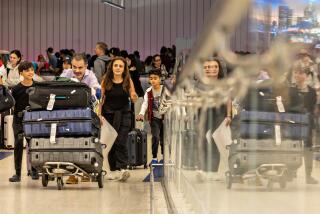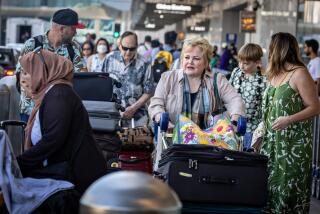Burbank Airport : PSA Still Lets Employees Skip Security Checks
More than a week ago, all the airlines flying out of Burbank Airport except PSA quietly began early enforcement of weapons-screening rules decreed by the Federal Aviation Administration.
The rules, imposed in the wake of the PSA crash that took 43 lives on Dec. 7, take official effect next week. They require aircraft crews and airport employees to go through the X-ray and metal-detector screening for weapons. Those rules have been mandatory for passengers since 1972.
Previously, most of airline employees had been exempt from screening. But in the wake of the PSA crash, government accounting office investigators criticized the FAA policy of allowing airlines to decide whether employees should be subject to security screening.
There are two screening stations at Burbank Airport, one under PSA’s jurisdiction in its own terminal, the other in the East Concourse, supervised by a committee made up of representatives of the 11 other airlines that operate from there.
“We made our own decision to put the 100% screening regulation into effect on Dec. 9,” said Steve Purvis, station manager for Alaska Airlines and chairman of the East Concourse security committee.
“We just decided to do it on our own. It was a unanimous decision by the representatives of all the airlines.”
Rule for All Flights
The FAA announced Thursday that the same rules will go into effect for all U. S. commercial passenger flights Monday. It will apply to everyone except uniformed law-enforcement officers.
“We’d been toying with the idea of doing this for quite a while anyway,” Purvis said. “When the news broke that the PSA crash might have been caused by a former employee, we just decided it would not be overreacting to do this.”
Committee members expected that the FAA would probably enact such a rule eventually, he said, but were prepared to enforce it on their own for some time, even if the FAA did not make it a requirement.
A spokeswoman at PSA’s San Diego headquarters, Kay Horner, said she would not comment on the airline’s security “because the FAA has ordered us not to talk about it.”
However, a Times reporter and photographer, who watched the two Burbank Airport security screening stations for more than three hours Friday, observed the new rules being enforced by all airlines except PSA.
At the East Concourse checkpoint, pilots, stewardesses and airport workers were required to go through X-ray and metal-detector screening. At the PSA checkpoint, they displayed their identification badges and passed through the unchecked lane used by exiting passengers. One uniformed stewardess even tried to go through the checkpoint, but security workers waved her around it.
Major Carrier at Airport
PSA handles about 46% of Burbank Airport’s passenger traffic.
At Los Angeles International Airport, as elsewhere in the country, enforcement of the rule is optional until midnight Sunday, said Don Miller, deputy executive director of the Los Angeles Department of Airports.
“However, I think almost all of the airlines are already enforcing it on their own,” he said Friday.
The new rules were brought on by the crash of PSA Flight 1771, which dived into a hillside near Cayucos, Calif., killing all 43 on board.
FBI and investigators for National Transportation Safety Board believe 35-year-old David A. Burke, a disgruntled former employee of USAir, PSA’s parent company, was able to board the flight in Los Angeles with a .44-magnum pistol, bypassing the security screening because he was known to former colleagues and may still have had an employee badge.
A note found in the wreckage indicated that Burke, a ticket agent who had been fired, was seeking revenge on his former boss, who was aboard the plane.
Pilots reported by radio that they heard gunfire in the passenger cabin. A recording device on board then registered a disturbance in the cockpit, which apparently ended with the pilots losing control of the plane.
Transportation Secretary James H. Burnley, in announcing the new rules, said “The stricter screening requirement means that all airline employees, including flight crews, will no longer be able to bypass the security-screening system by showing an employee ID card.”
Although there have been indications that flight crews might be annoyed by the requirement--the Air Line Pilots Assn. has complained that it will add to the problem of delayed flights--there was little adverse reaction to the new regulations in the first week of enforcement at Burbank, Purvis said.
He said that adding flight crews to the lines at checkpoints had slowed down the processing of passengers “somewhat.” However, he predicted that most passengers will be unable to tell the difference in the amount of time it takes to reach their planes.
Another area of concern after the PSA crash was the security of airport and airline worker badges, particularly those of former employees such as Burke.
GAO investigators, testifying before a congressional hearing, urged that the FAA improve control over ID badges at airports. They said at one major airport an estimated 6,000 of 38,000 ID badges for airport, airline and other employees could not be accounted for. The investigators did not name the airport, but a congressional source told reporters it was Los Angeles International.
The Los Angeles Department of Airports has differed with the count, estimating the number at “around 2,300 or 2,400.”
Victor Gill, spokesman for Burbank Airport, said the small size of the airport staff helped prevent problems of lost badges there. “We have just over 100 employees, far fewer than someplace like LAX,” Gill said. LAX directly employs about 1,200 workers.
In case of lost or unauthorized possession of a badge at Burbank Airport, Gill said, new badges could be issued to all employees in a short time, destroying the usefulness of a badge kept by a former employee.
More to Read
Inside the business of entertainment
The Wide Shot brings you news, analysis and insights on everything from streaming wars to production — and what it all means for the future.
You may occasionally receive promotional content from the Los Angeles Times.










